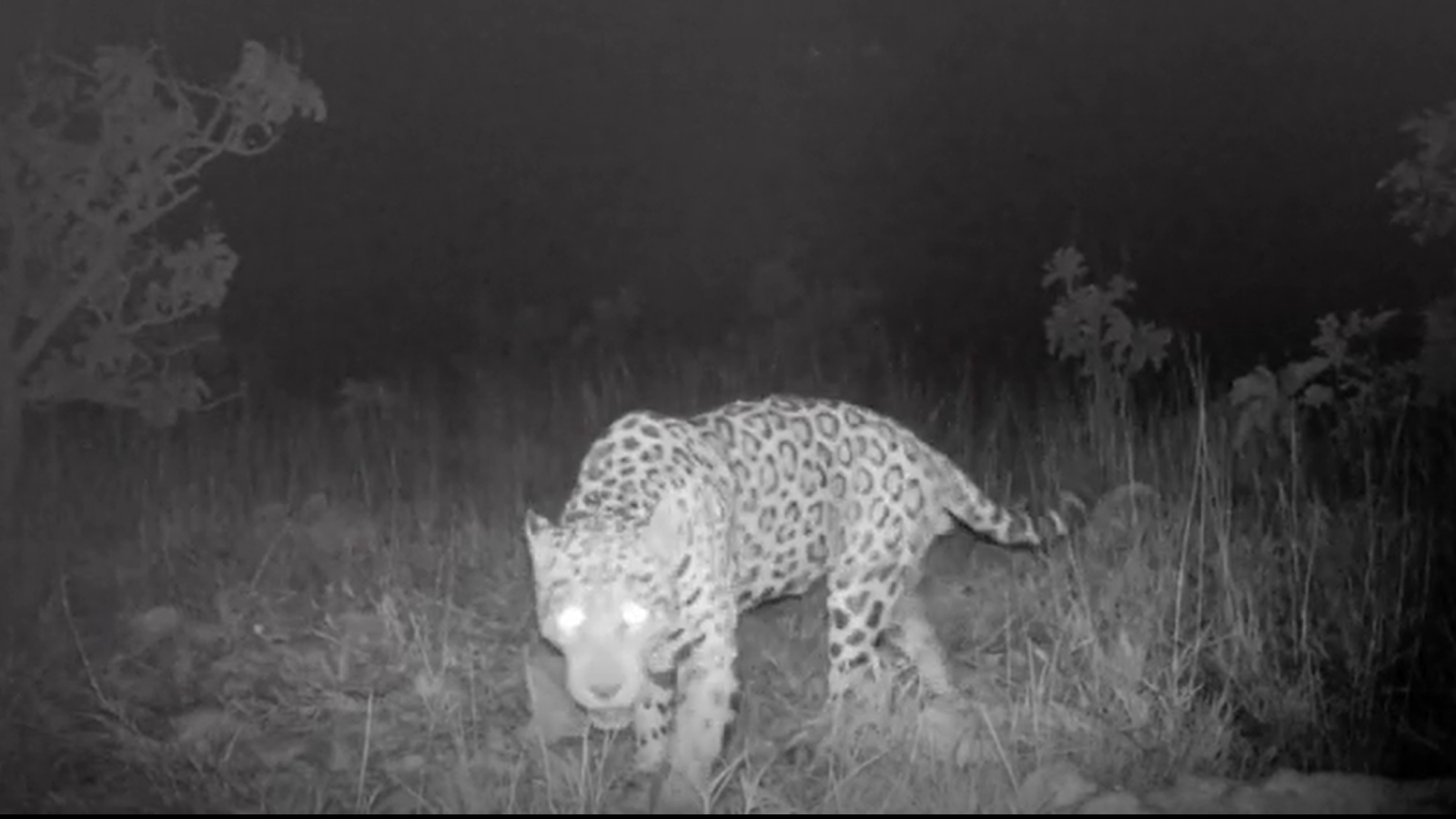By Richard Pallardy
Copyright livescience

Skip to main content
Close main menu
Live Science
Sign up to our newsletter
View Profile
Search Live Science
Planet Earth
Archaeology
Physics & Math
Human Behavior
Science news
Life’s Little Mysteries
Science quizzes
Newsletters
Story archive
Skyscraper-sized asteroid flyby
Mysterious hand positions on Maya alter
Anthropologist Ella Al-Shamahi on human origins
Treasure in scorched Roman-era house
Ant clones members of another species
Don’t miss these
Thousands of bumblebee catfish captured climbing waterfall in never-before-seen footage
Which animals can hold their breath underwater the longest?
Fishers discover first-of-its-kind bright orange shark with two rare conditions in Caribbean
Shark Week team discovers unusual ‘black makos’ off California coast
Extinct species
Bite marks reveal giant terror birds were potentially prey for another apex predator — humongous caiman
Extinct species
Ancient shark discovered deep inside world’s longest cave system
70 million-year-old hypercarnivore that ate dinosaurs named after Egyptian god
Extinct species
‘Most remarkable’ fossil of Jurassic sea monster from Germany is previously unknown species
A mysterious barrier in the Atlantic divides weird deep-sea jellyfish cousins
Domestic Cats
Why do cats hate water?
What’s the longest lightning bolt ever recorded?
515-mile-long lightning bolt that spanned 5 states is the longest on record
What is the world’s slowest animal?
Ancient predatory whale with big eyes and razor-sharp teeth was ‘deceptively cute’
Planet Earth
Amazon rainforest is approaching ‘tipping points’ that could transform it into a drier savanna
Land Mammals
Jaguar in Brazil smashes record for the species’ longest documented swim
Richard Pallardy
18 September 2025
A jaguar was captured on camera trap on an artificial island near the Serra da Mesa Hydroelectric Power Dam. The only way it could have gotten there was a very long swim.
When you purchase through links on our site, we may earn an affiliate commission. Here’s how it works.
A jaguar in Brazil has been documented making a record-breaking swim of up to 1.54 miles (2.48 kilometers). This distance is far beyond the previous verified record of around 650 feet (200 meters) for jaguars, according to the study authors.
Jaguars (Panthera onca) are adept swimmers, often inhabiting rainforest regions threaded with rivers that frequently overflow their banks. They dive into the waters of their Central and South American range without hesitation — but these dips are normally brief and undertaken to capture prey such as caimans, fish and turtles.
However, in a paper that appeared Sept. 10 on the preprint server bioRxiv, which has not been peer-reviewed, scientists documented a jaguar swimming a much greater distance.
You may like
Thousands of bumblebee catfish captured climbing waterfall in never-before-seen footage
Which animals can hold their breath underwater the longest?
Fishers discover first-of-its-kind bright orange shark with two rare conditions in Caribbean
The researchers reported that a male jaguar, first documented by camera trap photographs in May 2020 near the Serra da Mesa Hydroelectric Power Dam in Brazil’s Goiás state, swam at least 0.79 miles (1.27 km) to reach a small island in an artificial lake created by the dam.
Related: ‘It’s pretty incredible, the guy’s got three legs’: Watch lion looking for sex make record-breaking swim across treacherous river filled with crocs and hippos
A camera trap stationed on the island captured the same male four years later, in August 2024. The spot patterns on its coat were used to verify that it was the same individual. An analysis of the distance between the mainland and the island in the reservoir showed that there were two possible ways for the jaguar to have reached the island.
First, it could have swum 0.66 miles (1.07 km) to a small islet before reentering the water and then swimming the remaining 0.79 miles. If the jaguar swam directly from the mainland to the island without stopping, it would have covered 1.54 miles in a single go, the researchers said.
Sign up for the Live Science daily newsletter now
Get the world’s most fascinating discoveries delivered straight to your inbox.
Contact me with news and offers from other Future brandsReceive email from us on behalf of our trusted partners or sponsorsBy submitting your information you agree to the Terms & Conditions and Privacy Policy and are aged 16 or over.
The jaguar was filmed with a camera trap on a small island in an artificial lake created by the Serra da Mesa Hydroelectric Power Dam. (Image credit: Gabriel Caputo)
Even if the swim were undertaken over two journeys, this still represents a record-breaking distance for jaguars, the authors wrote.
It is unclear why the jaguar made the swim. “Prey in this region appears to be fairly evenly distributed, lead author Leandro Silveira, a biologist with the Jaguar Conservation Fund, told Live Science. “Nothing suggests the island has more prey, nor do the shorelines. We think he decided to explore a new area — more likely related to searching for females or territory than a lack of food.
“We generally expect animals to seek the best cost-benefit option for movements, choosing narrower, less risky crossings,” he added. “That’s why this record was so surprising.”
RELATED STORIES
—Texas puma genes rescue Florida panthers from extinction — for now
—Grumpy-looking Pallas’s cat photographed by camera trap in stunning photo from eastern Himalayas
—4 snow leopards spotted together on remote Pakistan mountain in rare footage
However, Fernando Tortato, a project coordinator for the big-cat conservation organization Panthera who wasn’t involved with the paper or observations, notes that long swims probably are not unusual for jaguars.
“Most of the jaguar population is located in the Amazon basin,” he told Live Science. “The main rivers there are in many places much larger than 1.6 kilometers. Some places are more than 10 kilometers. We know that jaguars do not see a river as a barrier.”
Tortato thinks the jaguar may have been seeking a new location to hunt capybaras (Hydrochoerus hydrochaeris), another common source of prey. “It’s quite common to see capybaras along these artificial lakes,” he said. “That’s my bet.”
Richard Pallardy
Live Science Contributor
Richard Pallardy is a freelance science writer based in Chicago. He has written for such publications as National Geographic, Science Magazine, New Scientist, and Discover Magazine.
You must confirm your public display name before commenting
Please logout and then login again, you will then be prompted to enter your display name.
Thousands of bumblebee catfish captured climbing waterfall in never-before-seen footage
Which animals can hold their breath underwater the longest?
Fishers discover first-of-its-kind bright orange shark with two rare conditions in Caribbean
Shark Week team discovers unusual ‘black makos’ off California coast
Bite marks reveal giant terror birds were potentially prey for another apex predator — humongous caiman
Ancient shark discovered deep inside world’s longest cave system
Latest in Jaguars
Male jaguar rivals pair up for years in unexpected bromances
Jaguar kills another predatory cat in never-before-seen footage
Jaguar Facts: Biggest Cat in Americas
Someone Just Killed One of the Last Remaining Jaguars in the US
Latest in News
Jaguar in Brazil smashes record for the species’ longest documented swim
RFK’s handpicked advisers are coming for the childhood vaccine schedule. Here’s what to know.
‘There’s no shoving that genie back in the bottle’: Readers believe it’s too late to stop the progression of AI
Oldest-known dome-headed dinosaur discovered sticking out of a cliff in Mongolia’s Gobi Desert
‘Rare’ ancestor reveals how huge flightless birds made it to faraway lands
‘The sun is slowly waking up’: NASA warns that there may be more extreme space weather for decades to come
LATEST ARTICLES
‘There’s no shoving that genie back in the bottle’: Readers believe it’s too late to stop the progression of AI
RFK’s handpicked advisers are coming for the childhood vaccine schedule. Here’s what to know.
What are the ‘magic numbers’ in nuclear physics?
Genetics: How do we inherit traits from our ancestors?
Even brief exposure to air pollution can push the placenta into an inflammatory state, lab study suggests
Live Science is part of Future US Inc, an international media group and leading digital publisher. Visit our corporate site.
Contact Future’s experts
Terms and conditions
Privacy policy
Cookies policy
Accessibility Statement
Advertise with us
Web notifications
Editorial standards
How to pitch a story to us
Future US, Inc. Full 7th Floor, 130 West 42nd Street,
Please login or signup to comment
Please wait…



